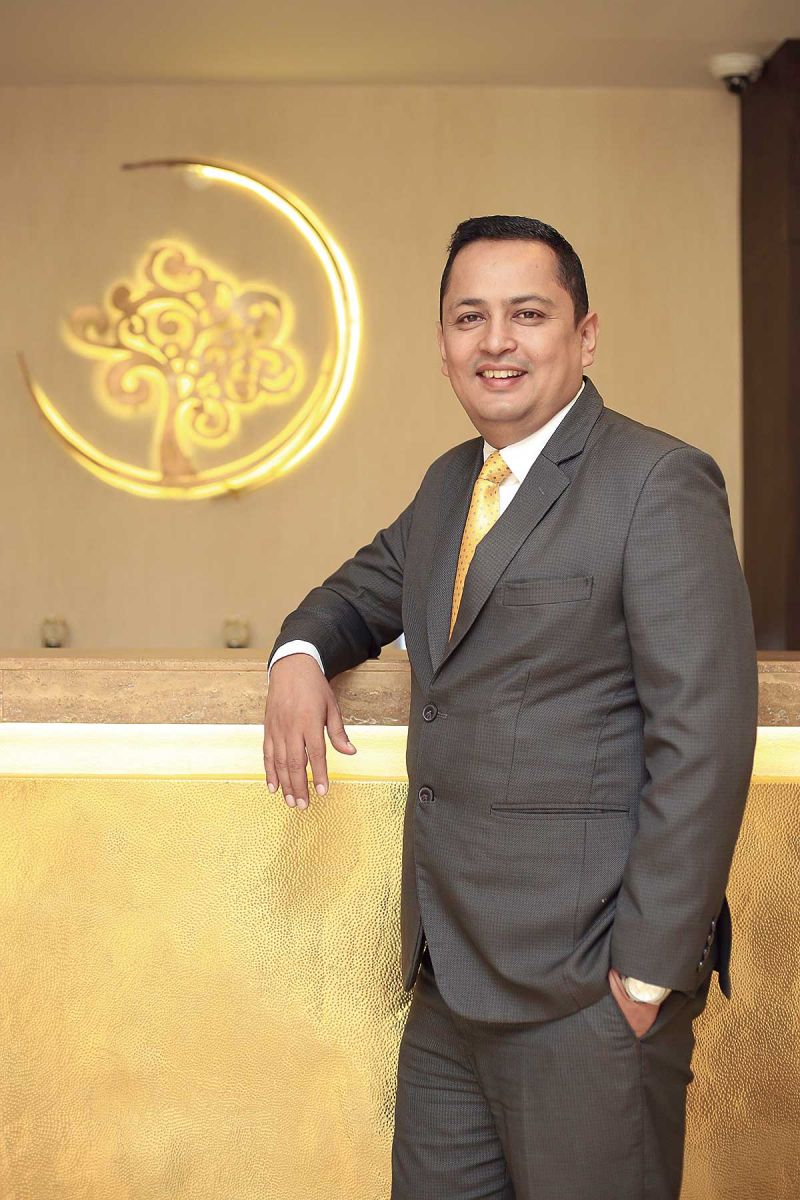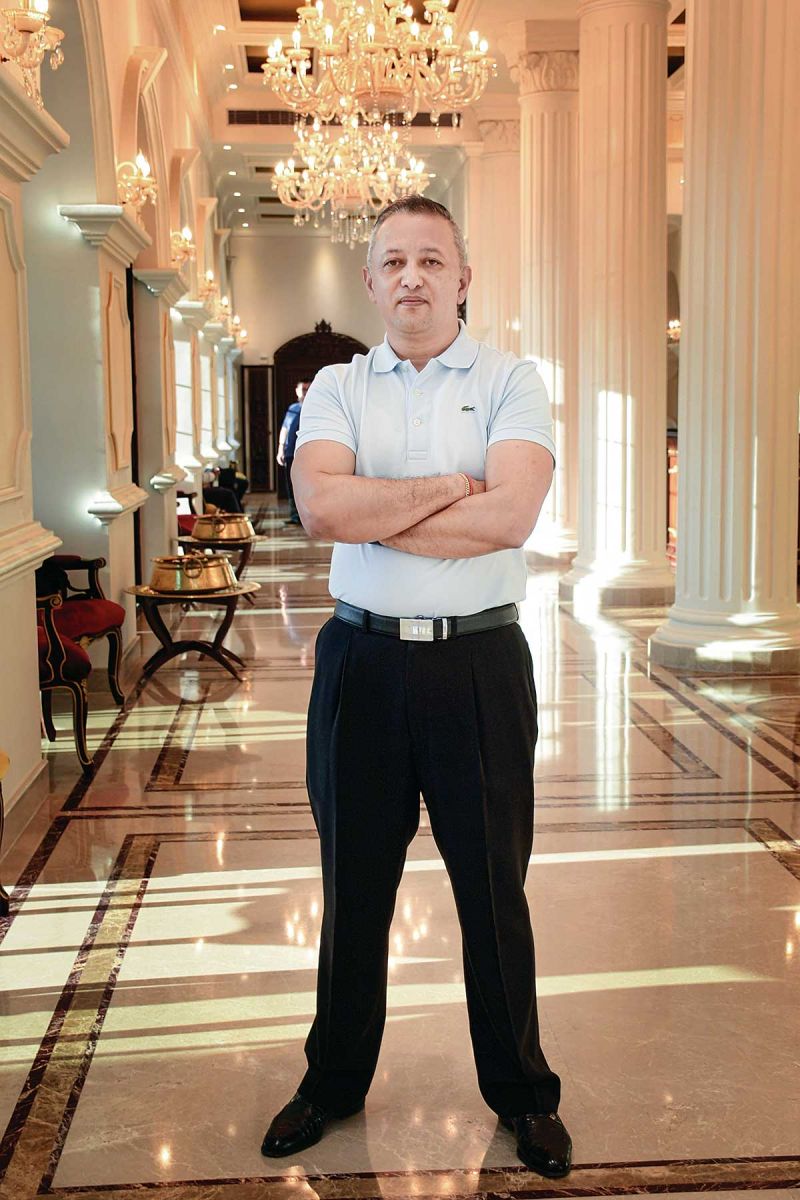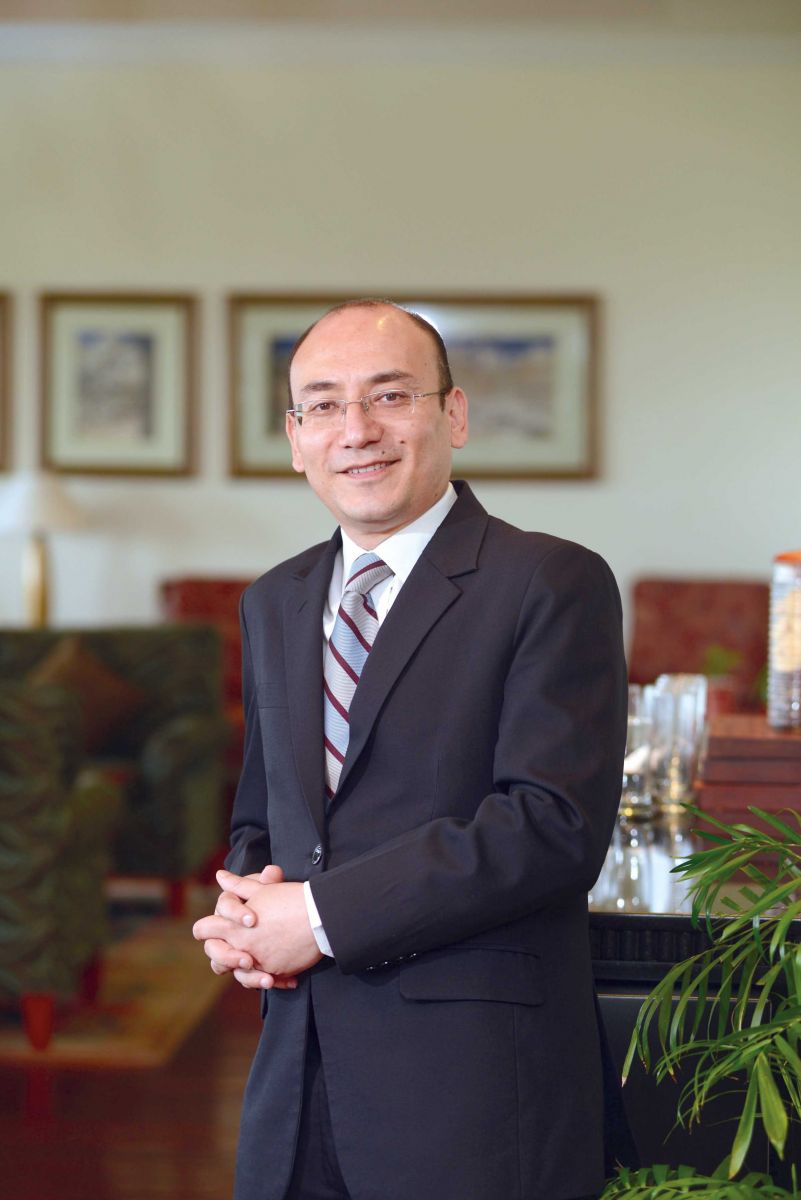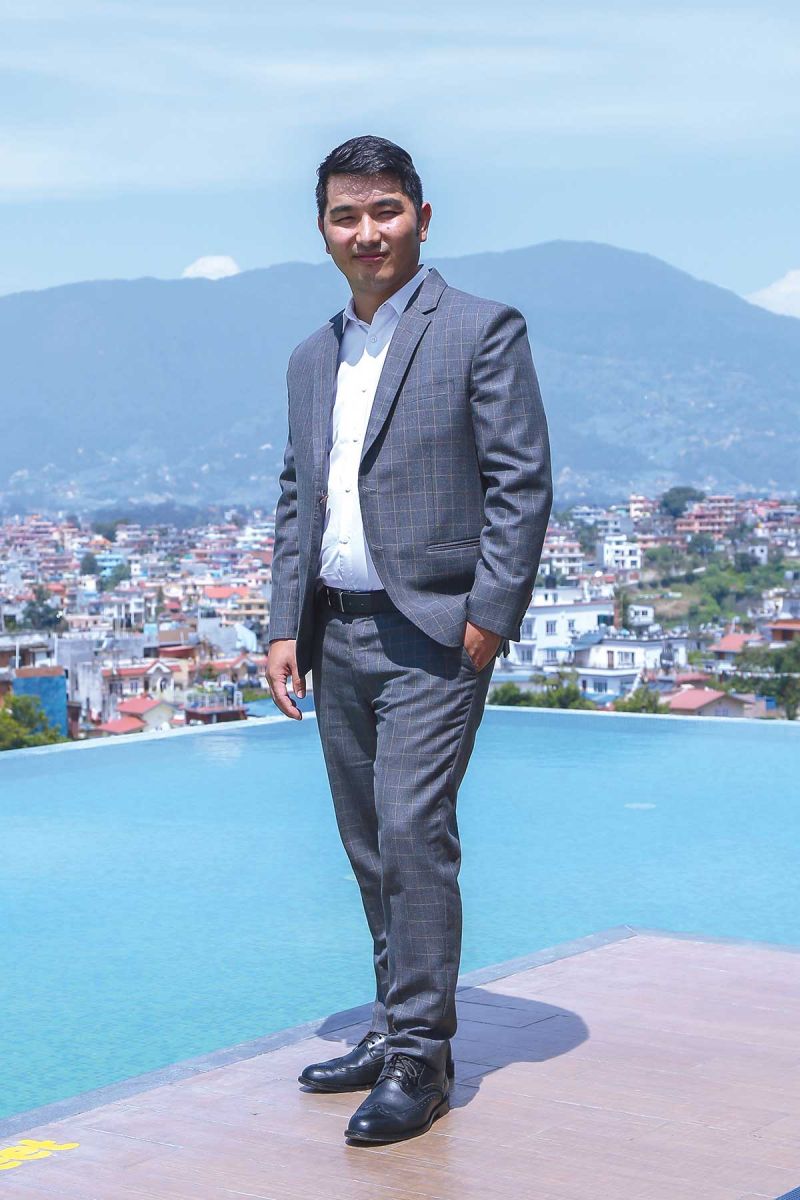Some top hoteliers answer our questions about their hotels and the broader hospitality outlook
 Amir K. Pradhananga has been General Manager of Hotel Mulberry since it opened on April14, 2017. The hotel has 67 spacious rooms.
Amir K. Pradhananga has been General Manager of Hotel Mulberry since it opened on April14, 2017. The hotel has 67 spacious rooms.
A lot of new hotels are coming up. Do you think it's too many, or that there'll be enough visitors to fill them?
As of now, difficult, with this current number of tourists, but I’m confident the number of tourists will also grow. Earlier there were limited hotels, limited marketing; now there are more hotels, more brains, more people working on marketing, so demand will also be created. Let’s be optimistic.
An example is, 10-12 years back, Pokhara had fewer hotels, now a lot of good ones have come up, before with less hotels there was an off season, now they are full year round; they have created a Nepali market.
I don’t know when the airports will get completed, the gateway has to be open, and we must make sure we don’t go into a price war—rather, do a service war.
How is your hotel doing today, and how do your bookings look for the next season or two?
We are feeling pretty optimistic, but also concerned about the insurance scam. If the insurance companies pull out, people won’t travel. The government has to take fast action, the more you delay the more it will decay—do not wait.
What do you think are the hurdles to further improving the tourism scenario?
The major thing is that all of us need to work together to control pollution; that’s one thing that’s killing the entire ambiance of this country. Not just the government, but also we as citizens and businesses need to do something. Some things our hotel is doing—we teamed up with Doko Recyclers. There are segregated trash cans in the room, the guests respect it. Also, we have them in the kitchen. And if a guest stays for only one night and the amenities are barely used, we give them to an organization that re-melts them and makes new ones and give them to those that can use them. We are trying to give back to the environment; it’s a small step, but it’s something.
We need to make sure there are sufficient trash bins around Thamel. If Nepal gets a reputation for being polluted, our value goes down.
In your opinion, what is Nepal’s tourism strength?
The people. No matter the situation, we always have a smiling face, backed up by natural beauty.
What is your favorite destination in Nepal, and what is your favorite lesser-known destination in Nepal?
Lesser known is Balthali—a small area, you see farms. It’s half an hour from Banepa,you can do a bit of hiking there.
To be honest, I seriously like Nagarkot. I can’t take the time to go to Pokhara and Chitwan very often, but Nagarkot is a day drive, and I normally go there with my family; and with my friends, I like driving down the Dhulikhel lane and on the Kakani side.
Could you tell us something about the tourists coming today? For instance, are we receiving more high-end tourists, or is it still mostly budget travelers?
The majority is still budget, but there’s a big change compared to five years ago, more high-paying people are coming. Building the infrastructure even without the market is bringing them.
There is huge potential in Nepal, that’s why I say don’t be afraid of more rooms, there’s so much potential for MICE tourism (meetings, incentives, conferences, and exhibitions). The giant corporate houses of the world can come and do their conferences here.
All kinds of hotels will have their own market. It’s not so much being competitors, but complementing each other.
Any final words?
Feedback from tourists was that rooms inThamelare cramped, the area is crowded, and you can’t find peace, so we’ve tried to do the opposite here—lobby size, hallway, rooms, all large; my smallest room is 306 square feet.
We’re trying to do something different in Thamel, something that Thamel was missing.

TsheringWangelGhale
Managing Director
Royal Singi Hotel
Opened in 1998; 95 rooms
Is the hotel industry self-sufficient to sustain in the future, considering the migration and exodus of workers?
I believe most of the workers are going overseas due to monetary reasons, and rightly so. However, in order to ensure there is a beneficial environment and structure to support worker's financial needs within the local tourism and hotel industry at higher salaries, it cannot be supported solely by increasing minimum salary every two years. The government and various tourism and hotel authorities need to work towards measures on how revenues can be increased, and a certain range of minimum rates [as per category of hotels] maintained as opposed to price cuts and increased costs, especially with newer hotels coming in. It is evident that operating costs will increase year after year, as most of what we use is imported and relies heavily upon foreign exchange and tax regulations.
Secondly, I have seen some initiatives already in place that provide vocational training in rural areas, allowing for the less privileged to be educated and/or trained with specific skills for the hotel industry. These are geared towards individuals who wish to remain in the country and provide for their families, and is an excellent approach towards talent development, growth, and retention.
The country is enjoying a period of political stability and tourist numbers seem to have increased. Do you agree?
Yes, absolutely. 2018 in particular. 2012-2014 were peak and 2015 was on the way to even more, then it was downhill. Now the country has gone bounced back, and the fall season of 2018 is very promising; this is why everyone’s building hotels.
With so many new hotels coming up, will there be enough visitors to fill them? Are there too many?
It’s not too many, given the potential of the destination itself. I don’t think we have enough rooms of a certain standard level of accommodation, the 3-5 star category. There was a massive MICE destination event held here in 2013 or 2014 and there weren’t enough rooms [of that standard].
The government has the vision of two million tourists by 2020—but to get from point A to point D, you have to go through points B and C. First, get back to 800,000, then 1 million, and so on.
We’ve been here for 20 years, and the renovations we’ve done enable us to give our clients what they need; we have the place and the people, we need the products and are building a new ballroom and boardroom, to capture the MICE market. We have a base of business partners and travel agents, and have got feedback from them about needed upgrades to our property. If you look deeper into the industry, there are a lot of hotels that are not up to the standard, not upgraded.
With your experience of having studied and worked abroad, what do you think hotels in Nepal do well, and what could they improve?
Generally it’s within the culture of the country itself to be very warmly welcoming, going back to rural areas, when travelers were welcomed into homes. As capitalization and commercialism increases, Nepal is in the forefront of being able to adapt to international tourism, it’s in our DNA.
In general, in order to improve, the responsible people need to oversee the hotels better, such as safety and standards. If you really want to become a star rated hotel, the criteria should be more than just how many rooms and amenities you have. I’ve just built a ramp and bathroom and a changing table in the bathroom for the handicapped; it was a decision I made to accommodate my guests, [but] in any other situation it would be mandated.
If you look at the development of the city of Siem Reap, they are not as developed as Kathmandu, but if you look at the state of their hotels and airport, they put us to shame. The government of Cambodia takes tourism very seriously. These are things that are achievable
Chinese tourists seem to be increasing; what is your hotel doing to attract more of them?
China is a huge market. When we attended the Himalayan Travel Market held at the Soaltee, there was a guest speaker whose presentation was about being China ready. [He explained that] there’s very few tourists now compared to what there could be. Everybody seems to be focusing on major cities, but you’ve got secondary cities with new money, they’re traveling to Europe and Africa. You need your hotel info ready in Mandarin, F&B options for Chinese guests, Chinese speaking staff, and so on.
We are planning for next year, getting China-ready. I don’t think the profitability is low. They are willing to spend, and I don’t think the rates should be really low. If your hotel is equipped and China-ready, you can work with the correct partners to drive the prices higher. PATA is organizing a relevant one-day workshop about this, and I will be there, I think it’s very important.
The people selling experiences in Nepal need to think differently, not just mass tourism. That’s great, but you need to get the right business as well. There’s a term a lot of people in the industry use—season/off season—but there shouldn’t be an off season, that’s only for trekking, mountaineering, adventure tourism, and so on. Nepal has so much more to offer than mountains, but are there people selling things other than mountains? Why are not selling enough culture.
To finish, what do you consider a must-visit Nepal destination?
I visited Rara Lake two years ago, it’s amazing! I studied in Switzerland for four years, and I felt the view in Rara was much better, no pollution, skies are blue. But I never hear tourists saying they’re going to Rara Lake, because they’ve never heard of it. We need to use social media and technology to market these places.
 PrajwolShanker Shrestha, Executive Manager
PrajwolShanker Shrestha, Executive Manager
Hotel Shanker
Opened in 1964, 94 rooms
The country is enjoying a period of political stability, and tourist numbers seem to have increased. Has that been true in your experience?
It’s very gradual, increasing from when the Maoist movement ended till the peak in 2015, but then it drastically went down after the earthquake. We have not yet reached what we achieved in 2015. Before,we also used to get more higher-paying clients, but they haven’t rebounded as much.
How is your hotel doing today, and how do your bookings look for the next season or two? Does it look promising?
It will grow gradually, but not that significantly. With all the new hotels being built, will they be able to fill them up?Many hotels will be ready by 2020; but [if] the tourists that are coming are at the same flow, the tourists will be divided, as they will have many choices. There is also not enough space at the airport to bring in so many people; even now, planes have to circle while waiting to land.
What do hotels in Nepal do well and what could they improve in?
There is good news, a lot of outside chains are coming, and with that, plus good private hotels like ours, it will make the city more vibrant, with more choices and more reasons for people to come here.
The private sector is doing good, but the public sector not as well—the roads, water, etc. are not getting better. The things that have improved in recent years are only the electricity situation, plus the private sectors’ communications.
Do you think too many new hotels are being built? Will there be enough tourists to fill them?
As per the number of flights currently coming in, it’s too many. The airport would have to be huge. It’s too many for the number of people the airport can bring in.
Chinese tourists seem to be increasing; has that been the case for your hotel, and how are you marketing to them?
In our hotel, Chinese occupy the highest number of room nights, and Indians are the second highest. Surprisingly, the domestic market occupies the third position, mostly NRNs and people who are traveling in and out of domestic cities, Nepali business corporate clients. That’s followed by the U.S., U.K., Australia, France, and the Netherlands. Chinese come all year round. They are very price sensitive, but we have an advantage, because our property is unique and appeals to them.
What is your favorite lesser-known destination in Nepal?
Some parts of the east on the way to Darjeeling, the Taplejung area, it’s famous with a certain group of tourists, but it’s not well explored. It’s a beautiful area: Ilam, Fikal; lovely landscape, tea gardens, Kanchenjunga views. That area has a lot of potential, but no one has developed hotels or resorts there. They even have better roads than Kathmandu.
Where is one place in Kathmandu you would tell a first-time guest to not miss?
Besides the monuments—Bhaktapur, Patan, Swoyambhunath—I would tell them to enjoy a mountain flight. Do something adventurous. If in Pokhara, go gliding, or do the zip line.
Any final thoughts?
Basically, I have a positive view on tourism, even though some days are down. In the future, it will definitely be up, but sometimes,we have to take the downturns also.
 Hyatt Regency Kathmandu; Opened in 2000, 280 rooms
Hyatt Regency Kathmandu; Opened in 2000, 280 rooms
Director of Marketing, Mr. SumanShrestha
How is your hotel doing today, and do you foresee any problems in the near future for the hotel industry?
Hyatt Regency Kathmandu as a hotel is doing well, given the growth seen in arrival figures for the country. Furthermore, as a brand we feel we are well received within the market as a product offering quality service and catering to our discerning customers. I believe this can only improve with programs like the planned Visit Nepal 2020 as well as the improvement envisaged for our airports and focus on infrastructure development. However, having said that, we do see a pipeline of supply which is planned for Kathmandu and other tourist destinations in Nepal, and a right mix of demand and supply would need to be looked into to make it a success.
Do you think we are now self-sufficient in terms of required manpower for the hotel sector?
The hospitality industry is not a new one for Nepal. Yes, we did go through a patch where we could not scale our product offerings and services, which did lead to a lot of skilled manpower moving to destinations such as the Middle East, but as a nation I believe Nepal has hospitality engrained in its DNA. We have the soft skills that are needed to make a guest’s experience a memorable one. Besides these, of course there are knowledge-based skills that are easily learned, and if I may speak for our hotel, we at Hyatt Regency Kathmandu consider learning and self-development to be one of our key areas of focus that is centered around our purpose, which states, “We care for people so they can be their best.”
In your opinion, why should a tourist come to Nepal?
Nepal has everything a tourist would want to explore. From its physical attributes with the highest mountain in the world, to the lush tropical forests of Chitwan and the flora and fauna that come with such varied climatic settings are truly amazing. To add to this, we have diverse cultures one can experience, as well as the warmth of the people of Nepal, which is very welcoming to a visitor. The country is rich in its culture, heritage, natural beauty, and biodiversity, moreover, the Nepali people are very hospitable.
Could you tell us something about the tourists coming today? For instance, are we receiving more high-end tourists, or is it still mostly budget travelers?
Global tourists are redefining themselves, and I think the only constant I see is that they all want an experience. Experiential tourism will be the way forward, and as a hotel and destination, it should be our model to give value for money to attract such a clientele base. At our hotel, we get a mix of clientele from those here for leisure or business or for a conference. With Nepal having a clear seasonality, our hotel has similar trends of arrivals from different nationalities throughout the year. However, being a 5-star hotel, we do tend to price ourselves accordingly, and are definitely catering to discerning travelers.
What do hotels in Nepal do well and what could they do better?
Nepal as a country is very hospitable, the genuine warmth you get in Nepal is truly its biggest asset. As an industry, we are people-centric, and I believe our teams in our hotel put it all together to make a great guest experience.
 TsetenTsatultsang
TsetenTsatultsang
CEO, Hotel Shambala
Opened in 2014
65 rooms
The country is enjoying a period of political stability, and tourist numbers seem to have increased. Has that been your experience?
For us, there’s been a minimal increase compared to other years. It was high prior to the earthquake, and is now slowly increasing. We also have a small hotel in Thamel, and we gauge it by both properties. There has been some increase, but not as much as before the earthquake.
A lot of new hotels are coming up. Do you think it's too many, or that there'll be enough visitors to fill them?
I think in the short run it might be problematic, because the rate of hotel development is increasing quickly, whereas the marketing for a country like Nepal is done by the NTB, and they work at a slow pace. But, in the long run, it will be good, depending on political stability and the work of the NTB. You have to be optimistic, though, and see opportunity where it is. Also, if NAC can get their act together, bring in numbers, and also get certified to fly in the EU again, that would be good. Additionally, if the airport moves toward the goal of staying open 24 hours a daythat will help a lot in bringing more flights and touristsinto the country, which will hopefully also bring flight prices down. For example, at the moment, it is cheaper for South Indians to fly to Malaysia or Singapore than Nepal, even though we are so close by.
What do you think are the challenges or issues that need to be addressed to further improve the tourism scenario?
I think, mainly infrastructure: better roads, better airports, and so on. We’ve had guests travel to Chitwan in the monsoon season, be stuck on the road for 12 hours, who then said “I’m never coming to Nepal again.” And, those who’ve had a bad experience will tell others. Not everyone feels comfortable flying on domestic flights, and they shouldn’t have to. Seeing the country by road can be aa great part of the experience of visiting Nepal.
Do you think we are now self-sufficient or stable in terms of required manpower for the hotel sector, or as more people have left the country for jobs outside, do you have trouble with that?
We do. I think one of our biggest challenges is finding skilled manpower, and then,keeping them. That’s been one of our key focuses for the last six months. We’ve accepted that’s part of the scenario. We are trying to get the right people at entry level and develop them. They might leave in a year or two, but we can help them grow, and try to keep the higher quality staff, reward them better, and accept that there’s just going to be a certain amount of turnover. If people see a career path, something they can grow into, they’ll be more likely to stay.
We’re also experiencing, with some forms of automation, such as better equipment,that we can reduce the need for manual labor, like in the kitchen, and we will try to incorporate that in different areas, if possible. There is also the need for higher wages, but you have to maintain a healthy balance ratio of income to expenses if you are going to stay in business.
Could you tell us something about the tourists you see coming today? For instance, are we receiving more high-end tourists, or is it still mostly budget travelers?
I don’t think we are moving into the high-end market, because high-end clients don’t want to deal with the various hassles, thechaotic traffic, etc. I’ve been doing this for five years, but I’ve spoken to people who’ve been doing it for ten years, and room rates haven’t increased much in the last five-ten years in the higher end hotels, though lower cost ones have gone up a bit due to the cost of living and wages.
It’s really a question of supply and demand; that’s why rates fluctuate so much between high and low season.The number of tourists isn’t increasing at a significant rate, but there is real potential for corporate clients: if the climate is good, there will be more people coming here for business.
Chinese tourists are increasing, and some people are changing their focuson marketing to them; are you also doing the same thing?
It’s not our main focus, mainly because they tend to come in large numbers, in group tours, and we don’t have enough rooms to accommodate them. With a smaller number of rooms, we have to aim for quality, rather than quantity, and we try to diversify our base as much as possible, so we don’t become a hotel that is known for catering to just one nationality.
What is one place in Kathmandu that you would tell a first-time guest to not miss?
I would recommend that they visit Kathmandu Durbar Square via Asan Bazaar. If they start in Thamel and walk along all the small alleys, through Asan, they will see how Nepalis live and shop and eat; it’s a truly local experience.










